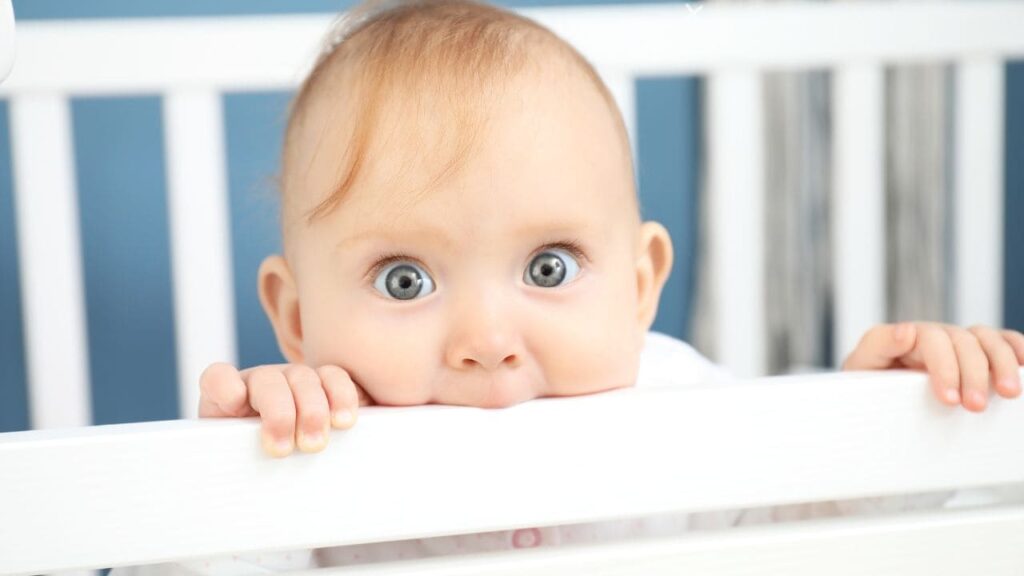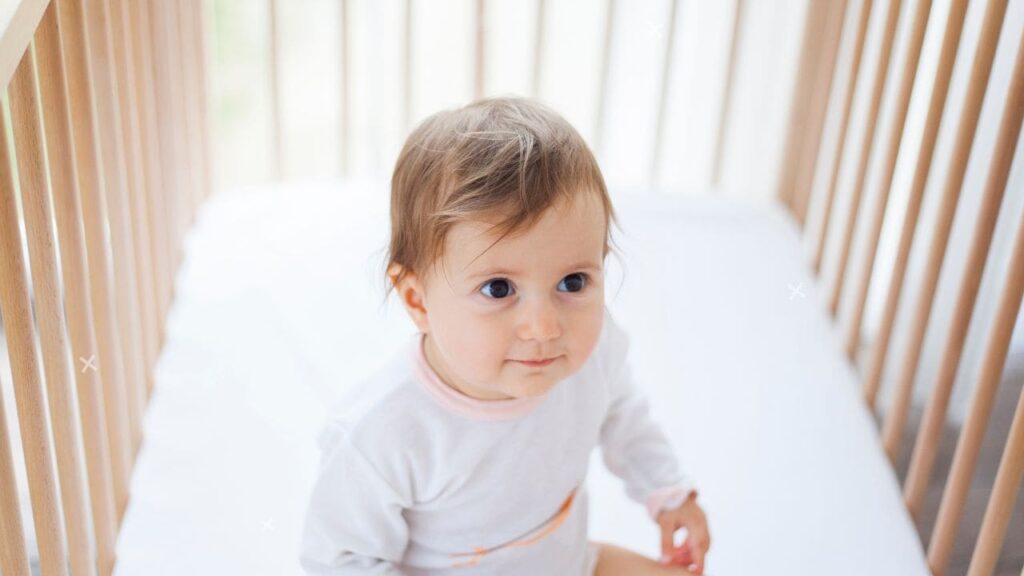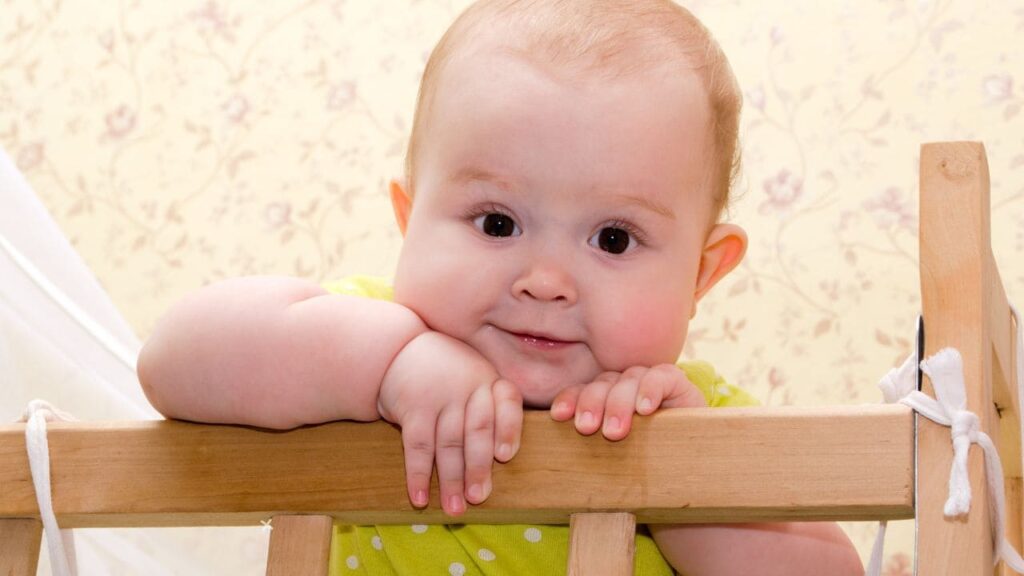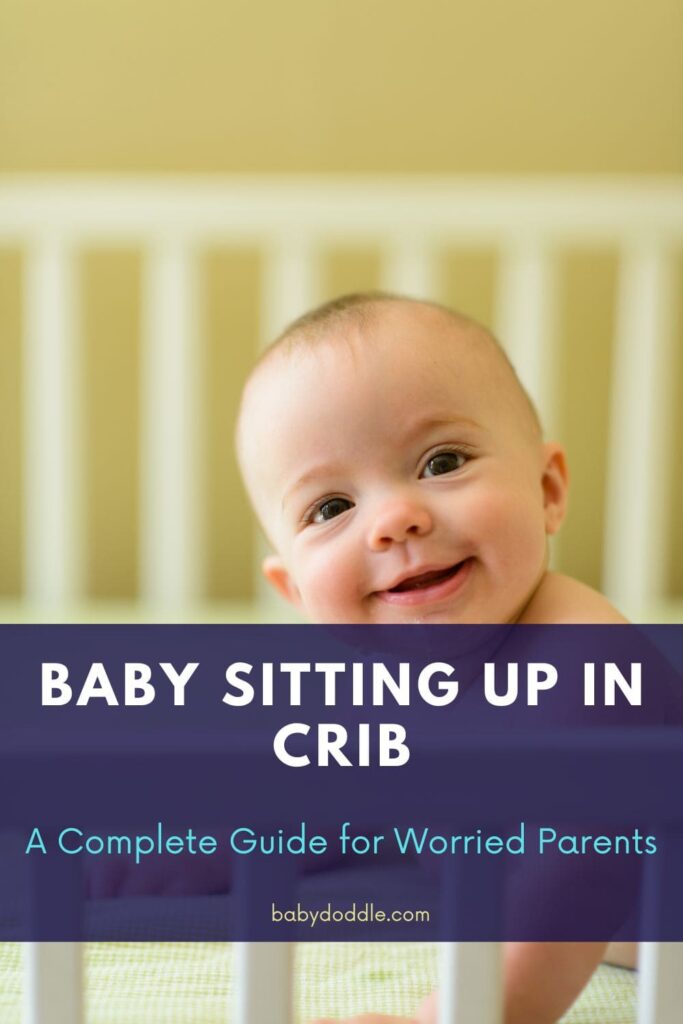As a parent, few things make your heart drop faster than looking over at your baby’s crib and seeing them sitting up looking right back at you. My first thought was – are they ready for sitting up in the crib by themselves? It’s a moment that simultaneously fills you with pride in their developing abilities and dread at how this new skill might impact bedtime and those blessed uninterrupted hours of sleep.
I’ve been there! When my daughter first pulled herself to a sit, it was right around 4 months and the early days of sleep training. The first time she popped up with a huge toothless grin instead of dozing off for a nap, my mind raced with worry. Was she ready to be sitting up on her own in the crib? Would it completely derail our sleep training progress? How would I ever get her to lie back down?
If you find yourself asking similar questions about baby sitting up in crib, take a deep breath mama and papa. Night waking and struggling with sleep transitions are totally normal and expected around the time babies learn to sit. The good news is there are lots of ways to encourage safe, independent sitting practice along with tips to help coach your baby to lie back down for soothing sleep.

When Can Babies Start Sitting Up in the Crib?
Before we dive into managing sitting up in the crib, it helps to understand the normal developmental timeline for this key motor milestone. At what age can you expect your baby to start displaying this new talent?
Most babies have the muscle strength, head control, and coordination to maintain a sustained seated position unsupported between 5 and 8 months old. Premature babies generally hit this milestone slightly later, closer to their original due date.
It all has to do with the development of core stability. Early sitting starts off shaky, relying on the stability of the tripod base formed by their two legs and bottom planted on the mattress. As trunk control improves around 6 months, babies rely less and less on that tripod to balance in a sit. 9 months to a year is when seated balance really hits its stride.
Now, hitting these milestones is not an automatic green light to let your 5 month old hang out sitting freely in the crib! Older babies in the 6-9 month range tend to have greater safety and control in the seated position specifically in the contained environment of a crib.
Next tip: look for signs your baby is ready before allowing sitting practice during crib time. An early or clumsy sitter could topple over and get injured. Let’s talk more about positioning that delicate little head safely.
Is My Baby Ready to Sit Up in the Crib?
Sitting up in the crib requires balance, head control, and trunk stability to avoid slumping over into an awkward and potentially dangerous position.
Here are some signs your baby is ready for supervised sitting practice:
- Holds head upright when supported at your shoulder – This head control indicates neck muscle readiness to handle the weight of their head in a seated position without strain.
- Pushes up onto hands when on tummy – Building arm muscle through activities like tummy time helps support sitting balances.
- Rolls between back and tummy – Rolling strength training helps develop the core control and coordination required for balanced sitting.
- Sits with support – Attempting to sit while propped by your hands or clutching furniture shows their motivation to master this skill.
- Supports weight on legs when stood – Standing while gripping your fingers points to lower body and core development for sitting upright.
Ideally, your baby should demonstrate most or all the above signs before you consider allowing them to attempt longer sits in the crib. A physician well-baby check is also recommended before introducing any new positions for sleeping or play.
If your infant seems like an advanced learner ready to tackle sitting earlier than 6 months, extra precaution is warranted. Earlier sitting can strain the delicate developing spine and interfere with bone growth in the hips sockets. Be sure to carefully supervise practice sessions and limit sitting duration.
Pay attention to any signs of fatigue like slumping forward or wobbling side to side. These are red flags baby might not have enough strength yet.
Ease into any sitting by providing plenty of support with blankets, crib gyms, or your hands upon initial attempts. Let’s explore just how detrimental sitting too early can be next.
| Milestone | Description |
|---|---|
| Holds head up | Sign of neck muscle control to handle head weight in sitting |
| Pushes up on forearms | Building strength through tummy time needed for sitting balance |
| Rolls over | Core and motor coordination for upright posture |
| Reaches for toys above | Visual tracking skills translating to balance abilities |
| Supports weight standing | Leg and glute power required for sustained sitting |
Dangers of Early Sitting in the Crib
It may seem like an exciting milestone when your wiggly 4 month old manages to pull themselves upright – but pumping the brakes is wise. Too early sitting comes with associated risks. Being aware of these dangers means taking appropriate steps to keep your baby safe.

Here are common hazards with early sitting in cribs:
Fall and Injury
An unsteady infant sitting too soon could easily lose balance, tip over, and bonk their head or get limbs stuck through crib slats. Tumbles risk serious injury like a concussion, black eye, or plastered limbs.
Obviously avoiding falls prevents the chance of babies self-soothing back to sleep only to suffocate on unsafe bedding. Start upright sitting practice only when babies have reliable head control and balance.
Orthopedic Problems
Letting an infant under 6 months sit places stress on an underdeveloped spine, hips, and other joint surfaces. Early bearing of body weight can contribute to future orthopedic issues like scoliosis or hip displacement.
Plagiocephaly and Brachycephaly
These scary sounding terms refer to flattened areas on the skull – both shape abnormalities possibly exacerbated by sustained positioning sitting upright too early. Allowing babies to repeatedly doze off in an unsupported sit can also directly contribute to a full-on flat head syndrome diagnosis later on.
Poor Sleep Quality
Attempting this new skill for longer than their limited endurance allows means babies often work themselves into an overtired state – missing sleep cues and struggling to settle back down.
Occasionally allowing supervised sitting practice around naps or bedtime is fine, but infants still need proper sleep positioning foundational for high quality rest – that being firmly on their backs.
Paying attention to when baby is developmentally ready along with limiting sitting duration mitigates all of these dangers perfectly fine. Being aware equips us to promote safe and successful sitting experiences.
Which brings us to the practical pointers for facilitating appropriate upright play/sleep in the crib – starting with useful products and positioning tricks during practice attempts.

How to Encourage Safe Sitting in the Crib
Achieving full sitting independence takes lots of patience along with trial and error. You can set your baby up for sitting success by intentionally creating ideal learning conditions in the crib:
Crib Gyms
Also called newborn play gyms, these fabric accessories stretch across the crib attaching to the sides with fitted corners and suction cups. The arch incorporates dangling toys, mirrors, and textures to occupy reaching hands.
While primarily for tummy time, gyms can double as amenable back support for sitting babies. The upright flexible padding helps prop babies into a steady tripod base. The attached visual and tactile elements provide further distraction from balance uncertainties.
They allow you to literally attach an extra steadying hand to the crib!
| Safe Sitting Tips | Descriptions |
|---|---|
| Use crib gyms | Crib gyms with dangling toys provide distraction and back support for sitting |
| Try supportive rolls | Rolling receiving blankets tightly behind lower back assists posture |
| Add cushy bedding | Extra cushioning like blankets or crib pads create a soft landing surface |
| Spot check sitting | Periodically peek in to ensure baby has not fallen or slumped over |
| Engage from outside crib | Chat, sing, or rattle toys to provide cognitive connection without overstimulation |
Supportive Blankets
Blankets balled up lengthwise also make handy posture aids. Similar to a bumper pad, the rolled bedding placed snugly behind their lower back serves as an anchored foundation piece.
The cozy barrier feels hug-like holding them reassuringly upright – less alarming than suddenly listing forward without anything to lean against. Plus grabbing and manipulating the soft texture keeps hands productively busy.
Crib Wedges + More Cushioning
Wedges lift and angle baby onto an ergonomically favorable incline that naturally tips them slightly back. Adding extra cushy layers (more blankets/sheets) creates an ultra-pillowy soft landing pad.
The boosted 3-D terrain challenges their balance while the abundance of padding cushions inevitable spills.
Supervised Practice Sessions
Hands-on help from mom or dad provides immediate reinforcement, celebrations, and redirection. Tactile input – securing around the waist, cupping the head delicately, caressing those chubby thigh rolls for heavyweight grounding – instills innate postural awareness.
Verbal narration during assisted sitting cognitively engages awareness of the quality of balance and areas needing adjustment i.e. “Uh oh, looks like you’re leaning way far forward, let’s tip your head back.” Celebrating small sitting accomplishments helps build confidence tackling this milestone solo eventually.
Consider setting up shop for sitting practice beside the crib during day wake windows at first. Solo attempts in the crib should always happen with attentive supervision to intervene with hands ready to swoop in if needed.
While allowing babies to work through some wobble builds resilience, catching them before a traumatic topple teaches proper alignment to avoid injury long term. Let’s discuss handling the inevitable – your baby tipping over while sitting in the crib.

What to Do If Baby Falls Over While Sitting
Despite your best efforts with positioning tools and balance assisting, cute gravity will more than likely win over at some point. Don’t fret! Tumbles are all part of the sitting learning curve.
Staying calm and responsive when falls happen promotes resilience over fear. No scolding about losing balance or rushing in to stand them right back up again. Hold your reaction to teach them how to self-recover both physically and emotionally.
Here’s a mature response process when baby topples over sitting in the crib:
1. Pause to Observe – Give them a moment to first try and remedy the situation themselves by rolling or pivoting into a revised position.
2. Verbal Reassurance – Offer encouraging words like “Oops, down you go, that’s alright. You can do it.” to diffuse any frustration.
3. Physical Assist – If truly stuck or upset, sweep in gently to help until they regain composure and look to try again.
4. Reset – Either allow further sitting practice or redirect into a needed change of activity.
Finding the balance between allowing some safe struggle to build grit over helicopter hovering takes attentiveness and trial and error. You know your baby best – watch for true distress before intervening.
Preventing falls should focus first on making the crib environment safer for sitting. Checking the height is properly adjusted to the lowest level eliminates the distance of descent. Using non-loose bedding avoids potential suffocation hazards.
Ultimately the crib should nurture restful sleep in whatever safe position baby best tolerates at this young age – which does mean firmly on their back the majority of the time.
Speaking of outgrowing the crib for a toddler bed transition…let’s explore determining when sitting freely leads to attempting to stand and climb out.
When to Transition Out of the Crib for an Older Baby
Typically between 12-18 months, the average cruising baby becomes increasingly more daring in pulling themselves fully upright – eager to propel those shaky legs into adventurous standing…and escape attempts.
When you spot these behaviors, a toddler bed transition might be on the horizon:
- Pulling up to stand using crib railings
- Getting up onto hands and knees consistently
- Climbing abilities – putting legs over the rails
- Extra crying/fussiness being constrained lying down
Trouble sleeping from constantly sitting up and struggling to lie back down comfortably are also clues they’ve likely outgrown the accommodations.
While each baby reaches this point at their own pace, watching for these collective signs indicates improving mobility and the crib becoming too constraining for their curiosity and energy level.
Transition timelines mean something different for every family situation too. Room sharing longer or swapping the crib for a floor mattress are alternatives fitting needs on a case-by-case basis.
When you do opt to convert to a toddler bed setup, maintain consistency surrounding sleep by preserving parts of the routine like white noise, loveys, and story time snuggles. Expect some initial adjustment as they revel in their newfound sleep space freedom!
This freedom means contending with the downside of mobility – up and down all night long! Having a plan for handling this restless obstacle course is key.
Which brings us to that lingering parent question – what DO you do when baby keeps sitting or standing up all night long? Let’s tackle some common frequently asked questions for real world answers.
Conclusion
While sitting can disrupt sleep routines initially, remember it signals exciting strength and coordination developments worthy of encouragement. Not to mention this new talent warms every caregiver’s heart after all the effort spent helping your little one hold their head up in those shaky newborn days.
Staying centered in responsive care for this temporary transition means your baby will ride out this learning curve no problem – emerging with improved dexterity to take on the world of walking, climbing, and so much more!
And you’ll tackle each novel mobility milestone to come from a place of greater confidence as parents, knowing just how to handle the situation thanks to expanding your toolbox of nurturing tricks with this sitting thing.
If frustrations do start stacking up, I encourage reaching out to your community – whether medical providers, online parenting groups, or real life relatives and friends. We all need backup when tolerances run thin! Better help and more rest for the weary await.
FAQ – Baby Sitting Up in Crib
How long can I allow my baby to sit in the crib at a time?
Aim to limit single sitting sessions to 10-15 minutes max until closer to that 9 months mark when trunk control really stabilizes. Watch for slumping, arm shaking and increased fuss as clues they are fatiguing.
Should I use any restraints to prevent falling?
No restraints! Allowing some spillage teaches resilience. Support with strategically placed blankets behind their back along with close supervision are safer alternatives over restricting movement.
Why does my baby get so fussy when sitting in the crib?
Mental and physical exhaustion from concentrating on stabilizing an upright posture triggers crankiness from feeling over-stimulated and unstable. Offer more supportive props or shift them onto their back to change the sensory input.
How long does this sitting in the crib phase last developmentally?
Usually around 2 weeks of tackling the skill consistently everyday before it clicks. But sporadic practice sits will likely continue as they revel and experiment with their newfound upright freedom at random sleepy times in the coming months!
While sitting up in the crib can feel scary and exhausting as a parent, remember – this too shall pass! Stay patient, consistent, and shower your blossoming baby-turned-toddler with compassion and support in their quest for independence. You’ve got this!












